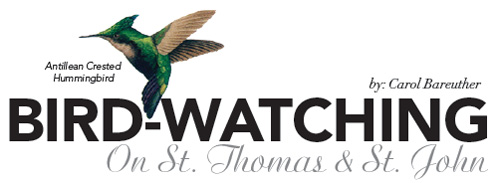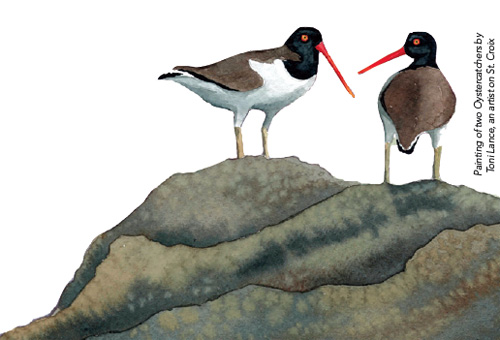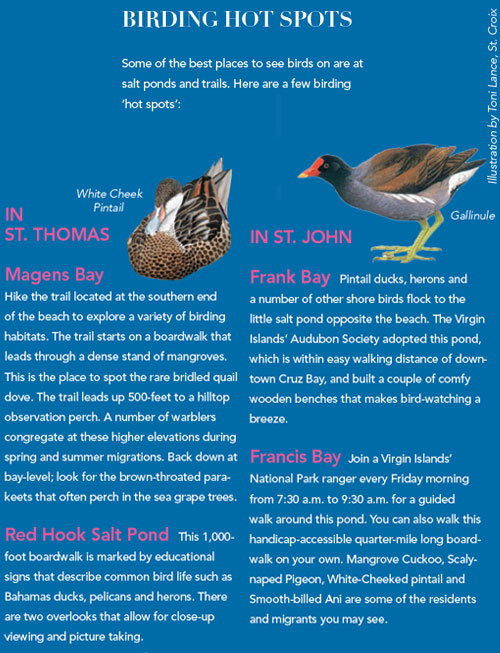 Over 160 species of birds make the U.S. Virgin Islands their home for either part or all of the year.
Over 160 species of birds make the U.S. Virgin Islands their home for either part or all of the year.
One permanent resident that is easy to spot is the Bananaquit. This palm-sized yellow-breast-ed black-crowned feathered friend has a white eye stripe and is the territory’s national bird. It’s also fondly called a ‘sugar bird’ because of its love eating granulated sugar. Locals enjoy leaving a bowl out on their patios in anticipation of some impromptu bird-watching.
There are a number of other year-round winged residents that are easy to spot from a variety of locales. These include the Gray Kingbird, Antillean Crested Hummingbird, Green-Throated Caribbean Hummingbird, Lesser Antillean Bull-finch, White-cheeked Pintail Duck, Smooth-billed Ani, Mangrove Cuckoo, Bridled Quail Dove, Zenaida Dove, Scaley-naped Pigeon and the Common Ground Dove.
 “Most of these birds are species found in the West Indies, says Laurel Brannick, education specialist for the Virgin Islands National Park on St. John. “A few may be seen on the U.S. main-land, but can be hard to spot. That’s why birding enthusiasts like to look for these species when they visit. For some, these species are a life bird or a new species on their birding list.”
“Most of these birds are species found in the West Indies, says Laurel Brannick, education specialist for the Virgin Islands National Park on St. John. “A few may be seen on the U.S. main-land, but can be hard to spot. That’s why birding enthusiasts like to look for these species when they visit. For some, these species are a life bird or a new species on their birding list.”
In the winter, the neotropical or birds that fly south for the winter will arrive. These include species such as the Peregrine Falcon, Ruddy Duck, American Bittern, Sora Rail, Whimbrel, Oystercatcher and Black-throated Blue Warbler.
“You never know where these birds will show up,” says Brannick. “For example, you may see a Peregrine if you are out on a boat trip. They can be found near sea-birds at our off-shore cays. You can even see some by a hotel in a puddle.”
Each year members of the Virgin Islands Audubon Society on St. conduct a Christmas Bird Count.
“The bird counts let us look at trends to see what birds are in decline, what birds are doing well, and what birds are expanding their range,” says Brannick. “For example, we have learned that ground birds like doves are in trouble because of the mongoose. That small birds like hummingbirds are affected by hurricanes and sometimes take a few years to get back to pre-hurricane numbers, and that we do get new birds like the Whit-winged Dove who showed up a few years ago and has stayed.”
A decline in the islands’ warbler population is another trend brought to light in the bird count.
“They are small migratory songbirds that are probably traveling here from as far away as Canada,” Brannick explains. “We used to get hundreds and now not anywhere near as many. This is probably due to many reasons such as feral cats, over development in traditional resting and feeding areas, obstructions and even climate change.”
For more information, call Laurel Brannick at: 776-6201, ext. 257.

